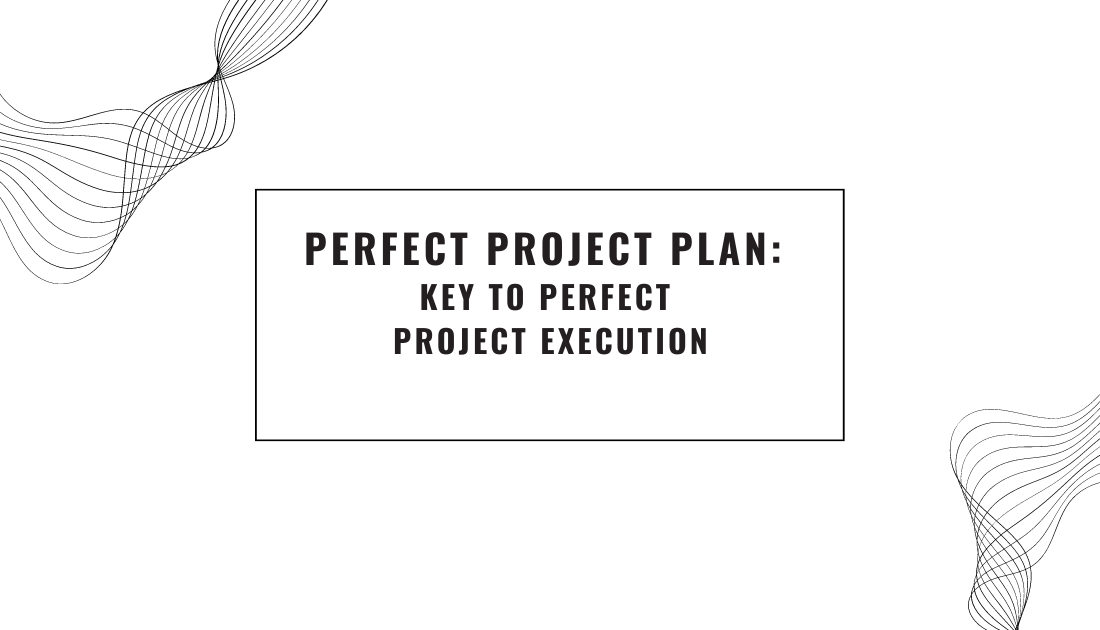Are you seeking to define perfect project? To define perfect project plan means encompassing a harmonious blend of efficiency, creativity, and effectiveness. When it comes to project execution, meticulous planning plays a pivotal role.
Often, the question arises: where do we even begin? With numerous considerations at hand, such as task durations, resource availability, meeting deliverables, and ensuring client satisfaction.
That’s where a well-crafted project plan steps in, laying the foundation for a comprehensive understanding of the project’s intricacies. By establishing the do’s and don’ts, a project plan allows us to discern the project’s requirements more effectively and outline the necessary steps for success.
How to Define Perfect Project Plan?
A project plan, also referred to as a project management plan, simplifies a manager’s life. It is a comprehensive document outlining the project’s scope, guiding you from the present to a desired future state.
Interested in learning how to create a project plan your team will adore? Read on for the steps and discover the answers to your burning questions.
A well-crafted project plan addresses key concerns, such as feasibility, timely completion, functionality, deliverables, implementation methods, flexibility for changes, progress tracking, and contingency plans for unavailability.
Why Does Project Plan Need to be Effective?
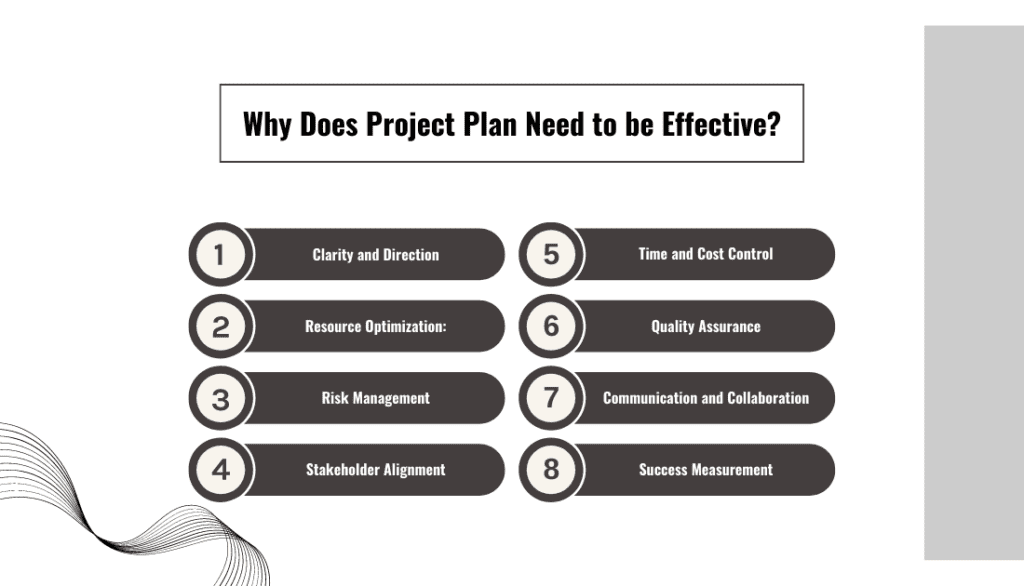
A perfect project plan needs to be effective for several important reasons:
- Clarity and Direction: An effective project plan provides a clear roadmap, outlining the project’s goals, objectives, and deliverables. It ensures that everyone involved understands the project’s purpose and the steps required to achieve success.
- Resource Optimization: With an effective project plan, resources such as time, budget, and personnel can be allocated efficiently. It helps prevent wastage and ensures that resources are utilized in the most productive and cost-effective manner.
- Risk Management: A well-designed project plan anticipates potential risks and challenges. It allows for proactive risk mitigation strategies and contingency plans to be developed, minimizing the impact of unforeseen events on the project’s progress.
- Stakeholder Alignment: An effective project plan involves key stakeholders from the beginning and considers their perspectives and requirements. This alignment fosters better communication, collaboration, and buy-in from stakeholders, enhancing the project’s overall success.
- Time and Cost Control: By setting clear timelines, milestones, and budgetary considerations, an effective project plan enables better control over project timelines and costs. It facilitates monitoring progress, identifying delays, and implementing corrective measures in a timely manner.
- Quality Assurance: A well-defined project plan includes quality assurance processes and checkpoints. It ensures that project deliverables meet predefined quality standards and customer expectations, enhancing the overall quality of the final product or service.
- Communication and Collaboration: An effective project plan establishes communication channels, roles, and responsibilities. It promotes effective collaboration among team members, departments, and stakeholders, fostering a cohesive and productive project environment.
- Success Measurement: An effective project plan sets measurable objectives and success criteria. It enables the project team to track progress, evaluate performance, and assess whether project goals have been achieved, providing a basis for continuous improvement and learning.
Overall, an effective project plan increases the likelihood of project success by providing a structured framework, guiding project execution, optimizing resources, managing risks, ensuring stakeholder alignment, and facilitating timely delivery of high-quality outcomes.
How to Create a Perfect Project Plan?
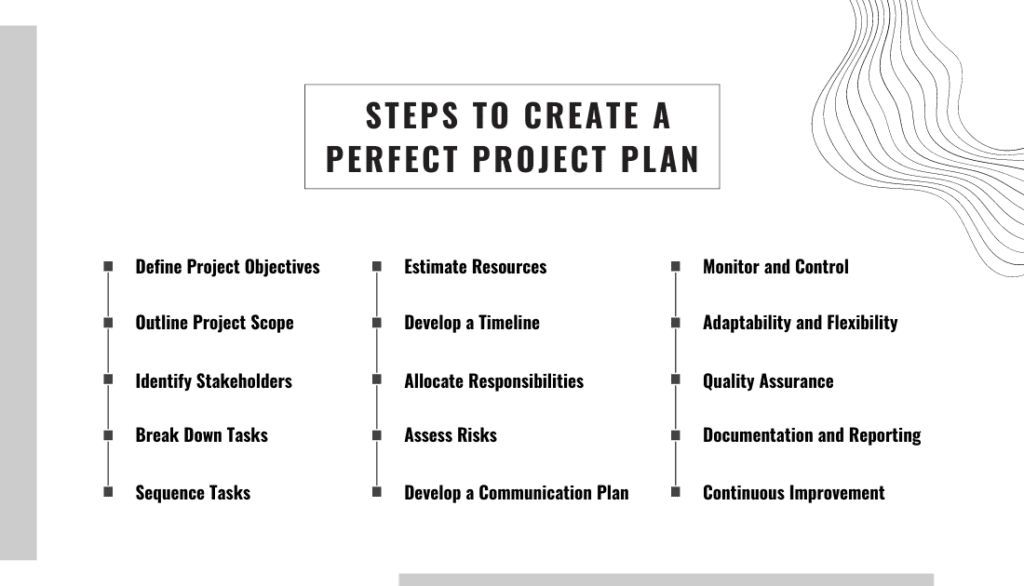
Outlining a perfect project plan requires careful consideration and meticulous planning. By following a systematic approach and incorporating key elements, you can create a project plan that sets the stage for success.
Let’s explore the steps to create a perfect project plan.
Define Project Objectives
It means clearly identifying the project’s goals, desired outcomes, and success criteria. Ensure they are SMART.
- Clearly articulate the desired outcomes and goals of the project.
- Make objectives specific, measurable, achievable, relevant, and time-bound (SMART).
- Ensure alignment with organizational strategies and stakeholder expectations.
- Prioritize objectives based on their importance and impact on project success.
- Communicate the objectives effectively to all project stakeholders for clarity and buy-in.
Outline Project Scope
Outlining the project scope is essential to creating a perfect project plan. Here are some key considerations:
- Clearly define the boundaries and parameters of the project.
- Identify the specific deliverables and outcomes to be achieved.
- Determine what is included and excluded from the project.
- Consider any constraints, limitations, or dependencies that may impact the project scope.
- Ensure that the project scope is realistic, achievable, and aligned with stakeholder expectations.
Identify Stakeholders
Identifying stakeholders is a crucial step in creating a perfect project plan.
- Identify all individuals or groups with an interest in or influence over the project.
- Engage stakeholders early on to understand their needs, expectations, and potential impact.
- Classify stakeholders based on their level of influence, support, or resistance.
- Establish effective communication channels to keep stakeholders informed and engaged.
- Continuously assess and manage stakeholder relationships throughout the project lifecycle.
Break Down Tasks
Breaking down tasks is a fundamental aspect of creating a perfect project plan. Key considerations:
- Decompose the project into smaller, manageable tasks or work packages.
- Identify the sequence and dependencies between tasks.
- Assign specific deliverables and responsibilities to each task.
- Estimate the duration, effort, and resources required for each task.
- Organize tasks logically and create a hierarchical structure, such as a work breakdown structure (WBS).
- Ensure tasks are clear, actionable, and aligned with the project objectives.
Sequence Tasks
Sequencing tasks is a critical aspect of creating a perfect project plan. Key points to consider:
- Determine the logical order in which tasks should be performed.
- Identify any dependencies between tasks, such as tasks that must be completed before others can start.
- Use project management techniques like network diagrams or Gantt charts to visualize task sequencing.
- Consider resource availability, constraints, and project timelines when establishing task sequences.
- Ensure the sequencing supports efficient project progress and minimizes bottlenecks or delays.
Estimate Resources
Estimating resources accurately is crucial for creating a perfect project plan. Some key considerations:
- Identify the types and quantities of resources required, such as human resources, equipment, and materials.
- Estimate the duration and effort needed for each resource to complete their assigned tasks.
- Consider resource availability, skill levels, and any constraints that may impact resource allocation.
- Use historical data, expert opinions, or industry benchmarks to inform resource estimations.
- Continuously monitor and adjust resource estimates throughout the project lifecycle.
Develop a Timeline
Developing a timeline is essential in creating a perfect project plan. Here are the key steps to consider:
- Determine the start and end dates for each task or phase of the project.
- Identify dependencies and sequence the tasks accordingly.
- Allocate realistic durations to each task, considering resource availability and constraints.
- Consider critical milestones and deadlines when creating the timeline.
- Use project management tools or software to visualize and communicate the timeline effectively.
- Regularly monitor and update the timeline as the project progresses.
Allocate Responsibilities
When creating a perfect project plan, allocating responsibilities is crucial. Consider the following points:
- Assign clear roles and responsibilities to team members based on their expertise.
- Clearly communicate the tasks, deliverables, and accountability for each role.
- Ensure a balanced distribution of workload and consider individual strengths.
- Encourage collaboration and ensure roles align with project objectives.
- Establish effective channels for communication and coordination among team members.
- Continuously monitor and adjust responsibilities as the project evolves.
Assess Risks
Assessing risks is a crucial aspect of creating a perfect project plan. Consider the following points:
- Identify potential risks and uncertainties that could impact the project.
- Evaluate the probability and potential impact of each risk.
- Develop risk response strategies, such as mitigation, avoidance, transfer, or acceptance.
- Prioritize risks based on their severity and likelihood of occurrence.
- Continuously monitor and review risks throughout the project lifecycle.
- Incorporate contingency plans to address unforeseen risks and minimize their impact.
Develop a Communication Plan
Developing a communication plan is essential for creating a perfect project plan. Consider the following:
- Identify project stakeholders and their communication needs.
- Determine the most effective communication channels, such as meetings, emails, or collaboration tools.
- Establish a communication frequency and ensure timely updates.
- Define the content and format of project communications.
- Foster a two-way communication approach to encourage feedback and address concerns.
- Regularly evaluate and adjust the communication plan to ensure its effectiveness.
Monitor and Control
Monitoring and controlling are critical for ensuring a perfect project plan. Consider the following:
- Regularly track project progress against the plan.
- Monitor key performance indicators (KPIs) to assess project performance.
- Identify any deviations or variances from the plan.
- Implement corrective actions to address issues and mitigate risks.
- Maintain effective communication channels for real-time updates.
- Continuously evaluate project outcomes and make necessary adjustments for improvement.
Adaptability and Flexibility
Adaptability and flexibility are key attributes for a perfect project plan. Take into account the following:
- Acknowledge that project plans may require adjustments due to changing circumstances.
- Remain open to feedback and incorporate lessons learned throughout the project.
- Embrace a proactive mindset to anticipate and respond to unexpected challenges.
- Foster a culture of innovation and adaptability within the project team.
- Regularly review and reassess the project plan to ensure its relevance and effectiveness.
- Emphasize the importance of being flexible while staying aligned with project objectives.
Quality Assurance
Ensuring quality assurance is essential in creating a perfect project plan. Take into account the following points:
- Implement quality control measures to maintain the desired level of quality.
- Define clear quality standards and criteria for project deliverables.
- Conduct regular inspections and reviews to assess compliance with quality standards.
- Incorporate testing, validation, and verification processes to ensure product/service quality.
- Address any identified issues or deviations promptly and effectively.
- Continuously improve quality processes based on lessons learned.
Documentation and Reporting
Documentation and reporting are crucial aspects of a perfect project plan. Consider the following:
- Maintain comprehensive project documentation, including plans, reports, and records.
- Capture project progress, milestones, and key decisions in written form.
- Ensure documentation is clear, organized, and easily accessible to stakeholders.
- Regularly update project reports to provide accurate and timely information.
- Use visual aids, charts, or graphs to enhance the clarity and effectiveness of reporting.
- Archive project documentation for future reference and knowledge sharing.
Continuous Improvement
Continuous improvement is a vital aspect of creating a perfect project plan.
- Foster a culture of continuous learning and improvement within the project team.
- Conduct post-project evaluations to assess project outcomes and identify areas for enhancement.
- Document lessons learned and best practices for future reference.
- Encourage feedback from stakeholders and incorporate their suggestions for improvement.
- Regularly review and update the project plan based on lessons learned and changing circumstances.
- Strive for ongoing refinement and optimization throughout the project lifecycle.
By following these steps and continuously refining your approach, you can create a project plan that is well-structured, aligned with stakeholder expectations, and capable of guiding the project to successful completion.
Tips for Making a Perfect Project Plan
Looking for additional inspiration to create strong and effective project plans? Save time and effort by leveraging existing successful project plans as a valuable resource.
Rather than reinventing the wheel for each new project, seek inspiration from these plans and use them as a guide for developing your own. Here are some essential tips to guide you towards success.
- Clearly define project objectives and ensure they are SMART.
- Break down the project into smaller, manageable tasks.
- Sequence tasks based on dependencies and logical order.
- Allocate responsibilities effectively among team members.
- Continuously monitor and control project progress and adapt as needed.
How Onethread Can Help Maintain a Perfect Project Plan?
Onethread, a collaboration platform, can significantly aid in maintaining a perfect project plan by providing essential features and functionalities that facilitate effective project management and seamless communication. Here are ways in which Onethread can contribute to project plan maintenance:
- Centralized Project Management: Onethread serves as a centralized hub for all project-related information, including timelines, tasks, resources, and milestones. Project managers can create detailed project plans and share them with team members, ensuring everyone is on the same page and aware of their responsibilities and deadlines.
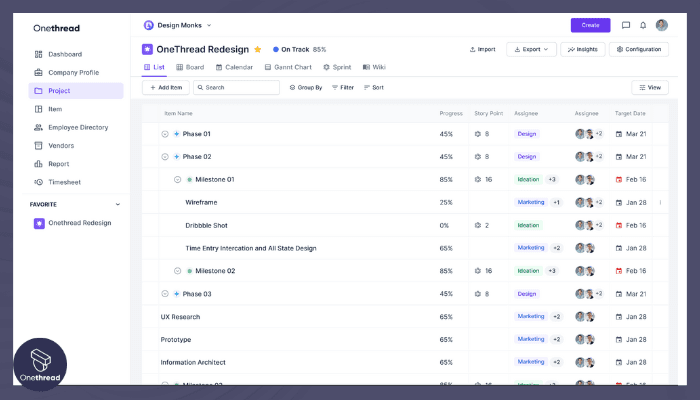
- Real-time Updates and Notifications: Onethread offers real-time updates and notifications, allowing team members to stay informed about project progress, changes, and new tasks. This ensures that any updates or modifications to the project plan are promptly communicated, reducing the risk of miscommunication or missed deadlines.
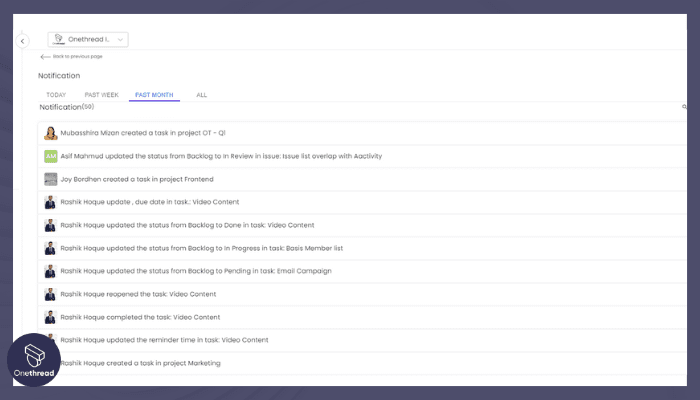
- Task Assignment and Tracking: Project managers can easily assign tasks to specific team members within Onethread and track their progress. This feature enhances accountability and transparency, as it provides visibility into each team member’s workload and ensures tasks are completed as scheduled.
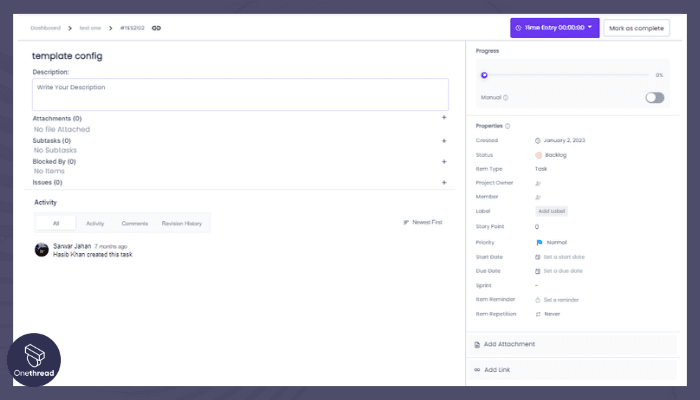
- Document Sharing and Version Control: Onethread enables seamless sharing and collaboration on project-related documents. Team members can access files, make edits, and keep track of version history, ensuring everyone works with the most up-to-date information, minimizing errors and discrepancies.
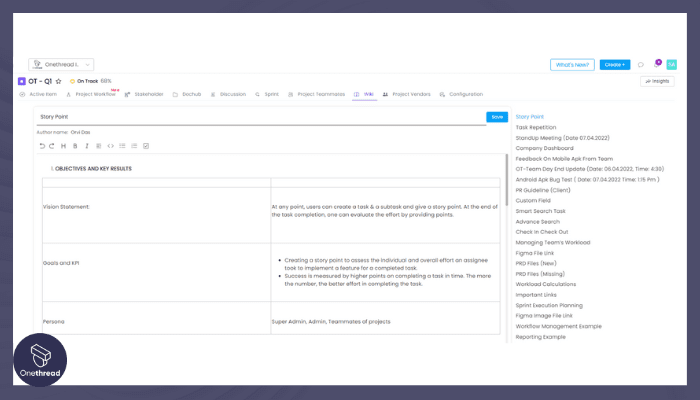
- Collaborative Discussions and Feedback: The platform facilitates open discussions and feedback, allowing team members to communicate, brainstorm, and resolve issues collectively. This collaborative approach leads to better decision-making and innovative solutions, which can be incorporated into the project plan for continuous improvement.
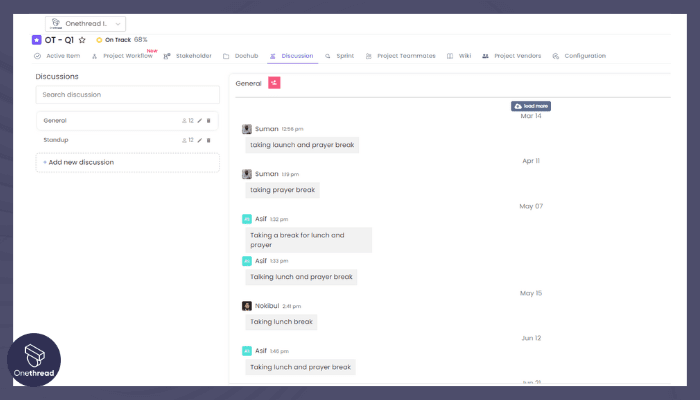
- Gantt Charts and Visualization: Onethread may include Gantt charts or visual project timelines, offering a clear overview of the project’s progress and critical milestones. These visualizations help project managers identify potential bottlenecks and make necessary adjustments to keep the project on track.
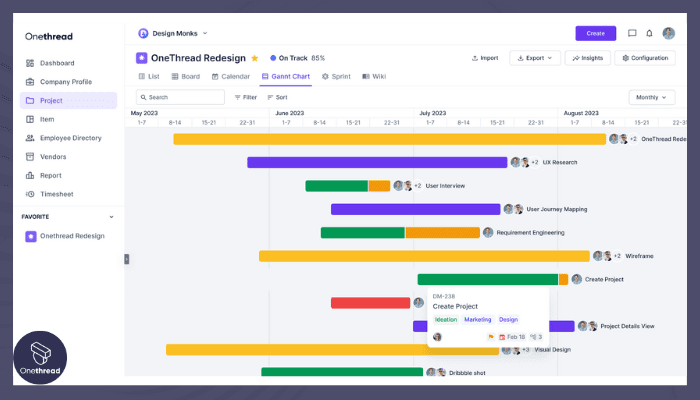
- Resource Management: Efficient resource management is crucial for maintaining a perfect project plan. Onethread can help track resource allocation, ensuring that the right people with the appropriate skills are assigned to tasks, maximizing productivity and minimizing delays.
- Risk Management: The platform can be used to identify and assess project risks, creating contingency plans and mitigating potential issues before they escalate. This proactive approach helps maintain project plan integrity and minimizes the impact of unforeseen challenges.
Final Words
Writing a perfect project plan is not an easy task. But with the right approach, it becomes achievable. Don’t forget to learn from experiences and seek feedback to improve future projects.
To define perfect project plan is vital for business success as it provides a clear vision and the necessary skills to ensure project completion.
If you’re embarking on a new project, following the above steps is key to its success. Gain a thorough understanding of the project’s objectives and deliverables to avoid any obstacles and effectively meet the required outcomes.
By implementing a perfect project plan, you’ll be equipped to navigate challenges and deliver results with confidence.
